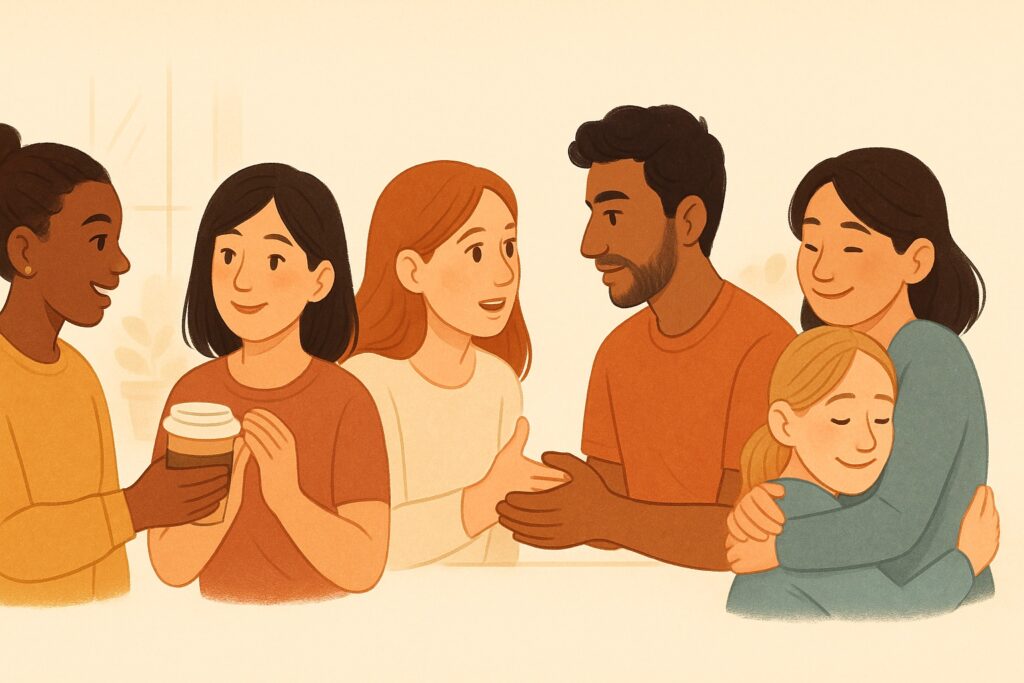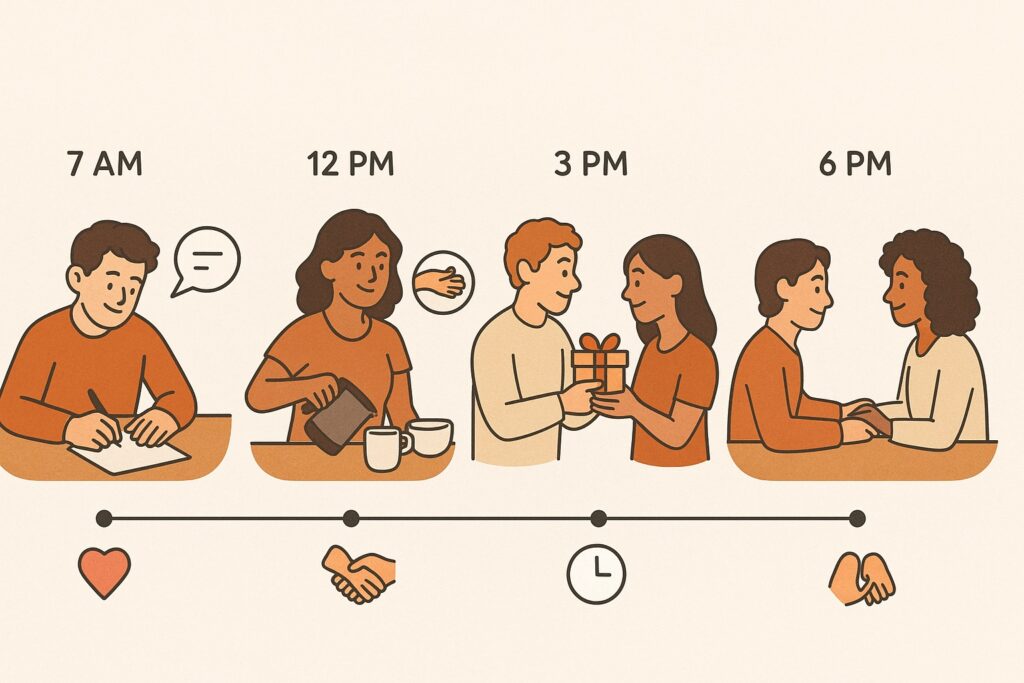Examples of Each Love Language in Daily Life: How to Show Love in Ways That Actually Matter

Examples of Each Love Language in Daily Life…
“I do so much for him, but he never seems to appreciate it.”
“She’s always buying me things, but what I really want is just to talk.”
“I tell her I love her every day, but she says she doesn’t feel it.”
Sound familiar? These frustrations happen when we’re showing love in our own language instead of our partner’s. You might be working overtime to demonstrate care through acts of service while your partner craves words of affirmation. Or perhaps you’re giving thoughtful gifts when what they really need is quality time.
The solution isn’t to love less—it’s to love more strategically. When you understand the five love languages and can recognize them in everyday moments, you gain the ability to make every gesture of love count.
Why Specific Examples Matter More Than Good Intentions
Understanding love languages intellectually is one thing; recognizing them in the messy reality of daily life is another. The difference between knowing your partner’s love language and actually speaking it fluently lies in the details—the specific moments, gestures, and expressions that translate abstract concepts into felt experiences.
Research in relationship psychology shows that couples who can identify and consistently practice specific love language behaviors report significantly higher relationship satisfaction. It’s not enough to know that your partner values “quality time”—you need to understand that for them, quality time means putting away your phone during dinner, not just being in the same room while you both scroll social media.
Words of Affirmation: The Power of Verbal Connection

For those whose primary love language is Words of Affirmation, spoken and written expressions of love, appreciation, and encouragement are deeply meaningful. But not all words carry the same impact.
Daily Examples That Work:
Morning Affirmations:
- “You look amazing today” (not just “you look nice”)
- “I’m so grateful to wake up next to you”
- “I love how you always make our mornings peaceful”
Appreciation for Character:
- “I admire how patient you are with the kids”
- “Your dedication to your goals inspires me”
- “I love how thoughtful you are with our friends”
Encouragement During Challenges:
- “I believe in you completely”
- “You’ve got this—I’ve seen you overcome harder things”
- “I’m proud of how you’re handling this situation”
Unexpected Verbal Gifts:
- Sending a text highlighting something specific they did well
- Leaving a voicemail expressing gratitude for something they might think went unnoticed
- Complimenting them to others when they can overhear
What Doesn’t Work:
- Generic compliments that could apply to anyone
- Praise that sounds obligatory or routine
- Compliments immediately followed by criticism (“You look great, but…”)
- Focusing only on appearance rather than character or effort
Real-Life Scenario:
Sarah notices her husband struggles with confidence at work. Instead of general encouragement, she gets specific: “I watched you explain that complex project to our neighbor last night, and I was amazed by how clearly you broke it down. Your ability to make complicated things understandable is such a gift.” This specific acknowledgment of his communication skills gives him confidence that transfers to his professional life.
Acts of Service: Love Through Helpful Actions

Acts of Service isn’t about grand gestures—it’s about noticing what would make your partner’s life easier and taking action without being asked. The key is anticipating needs and showing care through thoughtful helpfulness.
Daily Examples That Work:
Morning Service:
- Starting their car on cold mornings so it’s warm
- Preparing their coffee exactly how they like it
- Laying out their clothes if they’re running late
Easing Daily Burdens:
- Taking care of a chore they usually handle, especially when they’re stressed
- Filling up their gas tank when you notice it’s low
- Handling a phone call or task they’ve been dreading
Anticipating Needs:
- Bringing them lunch when they mention being too busy to eat
- Picking up their prescription on your way home
- Doing grocery shopping when you see they’re overwhelmed
Professional Support:
- Helping them prepare for an important presentation
- Taking care of home responsibilities so they can focus on a big work project
- Researching something they need to know about but don’t have time to investigate
What Doesn’t Work:
- Doing tasks poorly or halfway (it creates more work, not less)
- Helping only when asked or reminded
- Making a big show of your service or keeping score
- Choosing tasks that are convenient for you rather than helpful for them
Real-Life Scenario:
Marcus notices his wife has been stressed about an upcoming family visit. Without being asked, he cleans the guest room, stocks the house with her mom’s favorite snacks, and handles the logistics of airport pickup. His wife feels deeply loved because he anticipated her needs and took action to reduce her stress.
Receiving Gifts: Thoughtful Symbols of Love

This love language is often misunderstood as materialism, but it’s actually about thoughtfulness and symbolism. The perfect gift for someone with this love language says “I saw this and thought of you” or “I remember what matters to you.”
Daily Examples That Work:
Small, Meaningful Tokens:
- Bringing home their favorite candy from the store
- Picking up a flower from the garden for their desk
- Finding a book by an author they mentioned liking
Memory-Based Gifts:
- Recreating something from a meaningful date
- Bringing back a small souvenir from a business trip
- Finding something that relates to an inside joke or shared memory
Need-Anticipating Gifts:
- Replacing something they use daily that’s getting worn out
- Bringing them something that makes a routine task more pleasant
- Getting something they mentioned wanting but would never buy for themselves
Experience Gifts:
- Tickets to see their favorite band
- A reservation at a restaurant they’ve wanted to try
- A class or workshop related to their interests
What Doesn’t Work:
- Expensive gifts without thought behind them
- Generic gifts that could be for anyone
- Gifts that reflect your interests rather than theirs
- Last-minute gifts that feel like an afterthought
Real-Life Scenario:
Emma mentions missing the lavender tea her grandmother used to make. Three weeks later, her partner surprises her with a package of that exact tea blend he spent time researching and ordering online. The gift’s value isn’t monetary—it’s the demonstration that he listened, remembered, and took action to connect her with a meaningful memory.
Quality Time: The Gift of Presence

Quality Time goes beyond just being physically present—it’s about giving someone your full, undivided attention and creating moments of genuine connection.
Daily Examples That Work:
Undivided Attention:
- Having breakfast together without phones or TV
- Taking a walk and actually talking, not just walking side by side
- Asking about their day and really listening to the answer
Shared Activities:
- Cooking a meal together from start to finish
- Playing a board game or doing a puzzle
- Working on a project together, like organizing photos or planning a trip
Meaningful Conversations:
- Asking deeper questions about their thoughts, dreams, or concerns
- Sharing something vulnerable about your own experiences
- Having regular “state of the relationship” check-ins
Creating Rituals:
- Establishing a weekly date night with a no-phone rule
- Having a morning coffee routine where you connect before the day starts
- Taking a few minutes before bed to share the best part of your day
What Doesn’t Work:
- Being physically present but mentally elsewhere
- Multitasking during “quality time”
- Talking only about logistics or daily tasks
- Quality time that feels forced or scheduled without genuine engagement
Real-Life Scenario:
David and his teenage daughter establish “phone-free dinner Fridays” where they cook together and talk without devices. What starts as awkward conversation eventually becomes the highlight of both their weeks, as his daughter begins sharing things about school and friends that never came up in their rushed daily interactions.
Physical Touch: Appropriate Affection That Connects

Physical Touch as a love language encompasses all forms of appropriate physical connection, from casual touches to intimate moments. It’s about using physical contact to communicate care, comfort, and connection.
Daily Examples That Work:
Casual Affection:
- Holding hands while walking or watching TV
- A quick back rub while they’re working at their computer
- A hug hello and goodbye, even for short separations
Comforting Touch:
- A supportive touch on the arm during difficult conversations
- Rubbing their back when they’re sick or stressed
- Cuddling on the couch during movies
Playful Physical Connection:
- Dancing together in the kitchen while cooking
- Gentle tickling or playful wrestling
- High-fives or fist bumps for shared achievements
Intimate but Non-Sexual Touch:
- Massaging their feet after a long day
- Playing with their hair while they read
- Spooning or cuddling without sexual expectation
What Doesn’t Work:
- Touch that feels demanding or possessive
- Physical affection only when you want something
- Ignoring their comfort level or boundaries
- Confusing physical touch with sexual intimacy exclusively
Real-Life Scenario:
Lisa realizes her husband feels most connected through casual physical touch. She starts incorporating small touches throughout the day—a hand on his shoulder when passing by, holding his hand during TV time, a brief back rub while he’s reading. These small gestures create a continuous sense of connection that dramatically improves their emotional intimacy.
Recognizing Love Languages in Action
Once you understand what each love language looks like in practice, you can begin to recognize them when others express love to you, even if it’s not your primary language.
When Someone Shows Words of Affirmation:
- They compliment you frequently and specifically
- They encourage you during challenges
- They express gratitude for things you do
- They build you up in front of others
When Someone Shows Acts of Service:
- They help with tasks without being asked
- They anticipate your needs and meet them
- They take care of things you dislike doing
- They make your daily life easier in practical ways
When Someone Shows Receiving Gifts:
- They bring you small tokens of affection
- They remember things you’ve mentioned wanting
- They surprise you with thoughtful items
- They put effort into finding meaningful presents
When Someone Shows Quality Time:
- They give you their full attention during conversations
- They initiate activities you can do together
- They put away devices when spending time with you
- They prioritize being present with you
When Someone Shows Physical Touch:
- They initiate casual, appropriate physical contact
- They offer comfort through touch during difficult times
- They express affection through hugs, hand-holding, or cuddling
- They use touch to stay connected throughout the day
Adapting Examples to Different Relationships

Love languages aren’t limited to romantic relationships. Understanding how they appear in other contexts helps you build stronger connections across all your relationships.
In Parent-Child Relationships:
Words of Affirmation:
- “I’m proud of how hard you worked on that project”
- “You’re such a kind person—I saw how you helped your friend”
- “I love spending time with you”
Acts of Service:
- Helping with homework when they’re struggling
- Making their favorite meal when they’ve had a tough day
- Taking care of something they forgot so they don’t get in trouble
Receiving Gifts:
- Bringing home a small treat “just because”
- Finding something related to their current interest
- Remembering something they mentioned wanting
Quality Time:
- Having regular one-on-one time without siblings
- Engaging in activities they enjoy, even if you don’t love them
- Really listening when they want to talk
Physical Touch:
- Age-appropriate hugs and affection
- High-fives for achievements
- Comforting touch when they’re upset
In Friendships:

Words of Affirmation:
- “I’m so grateful to have you as a friend”
- “You always know exactly what to say”
- Complimenting them genuinely and specifically
Acts of Service:
- Helping them move or with a big project
- Bringing them soup when they’re sick
- Dog-sitting or babysitting when they need help
Receiving Gifts:
- Bringing back something small from your travels
- Remembering their birthday with something thoughtful
- “I saw this and thought of you” gifts
Quality Time:
- Regular friend dates without distractions
- Really being present during conversations
- Making time for activities you both enjoy
Physical Touch:
- Appropriate hugs hello and goodbye
- Comforting touch during difficult times
- High-fives and celebratory physical contact
Common Mistakes When Applying Love Language Examples

Mistake 1: One-Size-Fits-All Approach
Not everyone with the same love language appreciates the same expressions. One person might love public compliments (Words of Affirmation), while another prefers private appreciation.
Mistake 2: Going Too Big Too Fast
Grand gestures can feel overwhelming. Start with small, consistent expressions and build from there.
Mistake 3: Keeping Score
Love languages work best when expressions feel genuine and consistent, not transactional.
Mistake 4: Ignoring Timing and Context
A love language expression at the wrong time can fall flat. Quality time might not be appreciated when someone is stressed and needs acts of service instead.
Mistake 5: Assuming Your Way is Universal
Just because acts of service make you feel loved doesn’t mean everyone appreciates being helped in the same way.
Building Your Love Language Vocabulary
As you discover your own love language and observe others, start building a personal vocabulary of specific expressions that work.
Create a Personal Love Language Dictionary:
- For yourself: What specific expressions within your love language resonate most?
- For your partner: Which particular examples of their love language do they respond to best?
- For family/friends: How does each person uniquely prefer to receive their love language?
Keep Learning and Adapting:
Love language preferences can be nuanced and may shift with circumstances, stress levels, or life changes. What worked last month might need adjustment now.
Making Love Language Examples Part of Daily Life

The goal isn’t to perfectly execute love language expressions every day, but to build awareness and intention into how you show care for the important people in your life.
Start Small:
- Choose one person and one love language expression to focus on this week
- Pay attention to their response and adjust accordingly
- Build consistency before adding complexity
Stay Observant:
- Notice what expressions generate the strongest positive responses
- Ask for feedback: “What makes you feel most appreciated?”
- Be willing to try new approaches if something isn’t working
Remember the Bigger Picture:
Love languages are tools for connection, not rules to follow perfectly. The heart behind the gesture matters as much as the execution.
Conclusion: From Understanding to Action

Knowing the five love languages is valuable, but seeing them in action through specific, daily examples is transformational. When you can recognize a partner’s need for quality time in their request to “just talk for a few minutes,” or understand that your friend’s habit of bringing you coffee is their way of showing love through acts of service, you become fluent in the language of love itself.
The examples shared here are starting points, not scripts. The most meaningful expressions of love language will be the ones you discover through attention, experimentation, and genuine care for the people who matter most to you.
As you begin implementing these examples, remember that understanding love languages is an ongoing practice, not a one-time lesson. Each relationship will teach you new dialects within these languages, and each person will show you unique ways that love can be expressed and received.
Ready to Put Love Languages Into Practice?
Understanding your love language through examples is just the beginning. Take our comprehensive love language quiz to identify your primary and secondary languages, then use these practical examples to start speaking love more fluently in all your relationships.
Discover Your Love Language Now
Want to dive deeper into specific love language challenges? Learn what to do when you and your partner have different love languages, and discover strategies for speaking a love language that doesn’t come naturally to you.


[…] While often associated with romantic relationships, Words of Affirmation are equally important in family, friendship, and professional contexts. […]